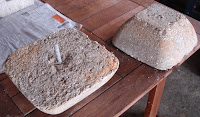
Is a project ever finished? One of the charms of a Japanese garden is the uncluttered minimalism so knowing when to stop might be a problem as naturally I desire to have at least one of everything in the garden.
Things that could be found in a Japanese garden:
- sand or pebbles
- rocks
- water
- plants
- stone lantern
One of the things I noticed often in Japan was the treatment given to the trees in the gardens. Virtually every tree was pruned and molested in various ways to give it a particularly Japanese look. I tried to ask people about this when I was in Japan and even to see if there were instruction manuals in the bookshops, without success. It wasn't until December while playing on Google that I discovered the world of Niwaki.
Niwaki is the Japanese word for "Garden trees" I purchased Jake Hobson's book on the subject and now no plant is safe in my garden. For my garden I decided that the main tree would be a Radiata Pine. Apparently Pines are the most commonly used trees in Japanese gardens and although Radiata Pine is not native to Japan it can make a good Niwaki. The other reasons for using a Radiata include
- the potted pine trees unsold before Christmas are deeply discounted in the weeks following
- they grow fast and are very hardy (I probably won't kill it)
- they are frowned upon by many gardeners and their image needs a lift, in my opinion
I planted the Pine on an angle and have used some steel stakes to produce a bend in the trunk this Autumn and the following Spring the Niwaki processes of Momiage and Midoritsumi will begin in earnest.










